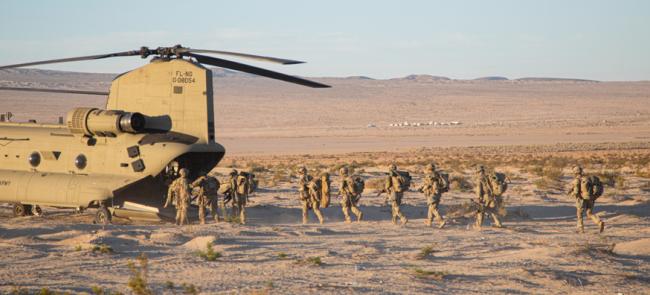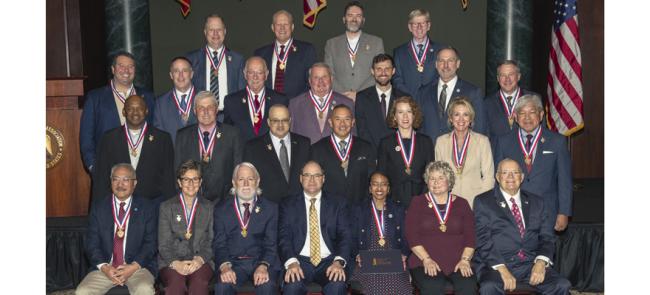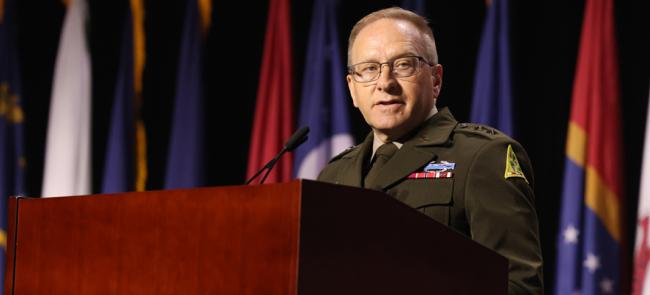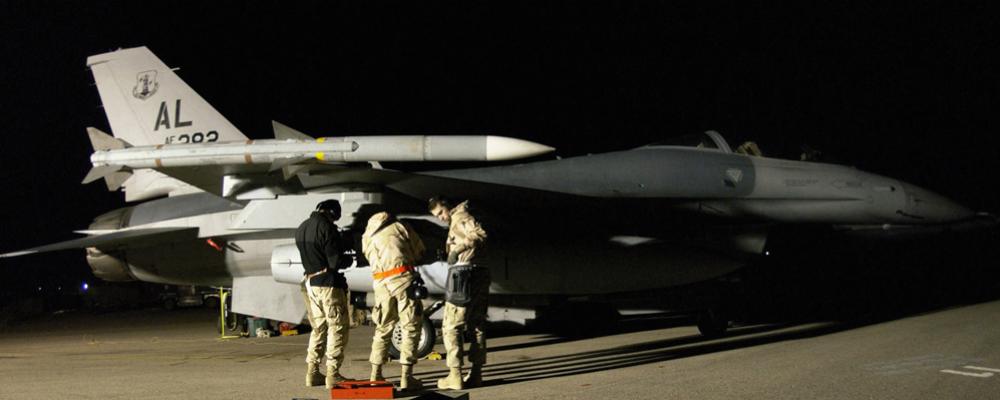
The Art of ACE
People often ask me about my favorite piece of Air Force equipment. You probably think it’s one of the two fighters I spent most of my career flying — the A-10 Thunderbolt II (aka Warthog) or the F-16 Fighting Falcon (aka Viper). But it’s neither.
My favorite piece of Air Force equipment is the 10K forklift.
I didn’t always think this way. My perspective changed after commanding the 410th Air Expeditionary Wing in the opening phase of Operation Iraqi Freedom.
This mostly Air National Guard wing was very successful. Our A-10s and F-16s destroyed Iraqi forces and equipment across western and central Iraq, performed search-and-rescue missions and supported coalition forces and ground-based air defense units. Pilots also conducted more than 200 close-air support missions in support of special operations units (see below).
But not one combat sortie would’ve been possible without 10K forklifts, other support equipment and the folks who operated them. They quickly built a fully functioning airbase where there previously wasn’t one. Without them, it would’ve been mission failure.
Today, the Air Force believes a network of quickly established forward operating bases, like the one we built in the desert 20 years ago, is critical to projecting air power. This is especially true in the Indo-Pacific region, where traditional bases are scarce and increasingly easy to target and put out of action.
The new concept of agile combat employment reflects this reality. It has commanders, planners and logisticians across the Air Force thinking differently about launching, recovering and maintaining aircraft. But there is also an element of art involved. The challenge is becoming masters of this art when limited time and the tyranny of distance are present. The lessons learned by the 410th AEW can be instructive.
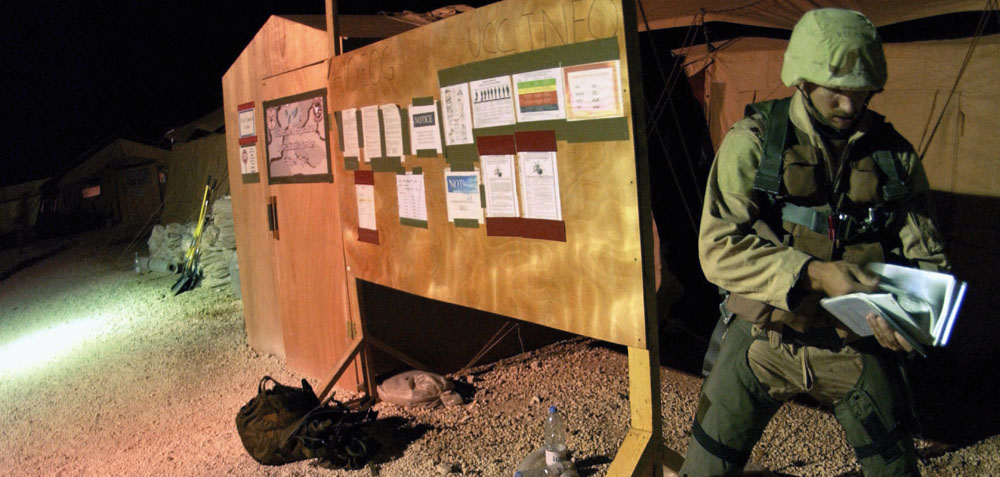
(STAFF SGT. BENNIE J. DAVIS III)
Our wing was conceived during a discussion I had in late 2002 with then-Lt. Gen. T. Michael “Buzz” Moseley, the commander of U.S. Central Command Air Forces and an old friend. At the time, I was the commander of the Alabama Air Guard’s 187th Fighter Wing. General Moseley wanted to know if I could organize an air-expeditionary wing, build an airbase in the Jordanian desert and perform 24/7 combat operations for an undetermined amount of time.
“Oh yeah, you may have only 60 days to get this done,” he added.
As a career fighter pilot, I’m always up for a challenge; however, you also have to know your limitations. I knew I could lead a wing. I was less confident about building airbases, particularly in the desert, or organizing a 3,000-person wing with airmen from all over the globe.
I told General Moseley I would give it my best effort, but it sounded like it wouldn’t be easy. “Sid, if it was easy, they would call it bowling,” he responded.
It helped that I knew what I didn’t know. I have never been a civil engineer or a logistician. However, I have known some good ones. I also knew the old axiom “amateurs talk strategy, professionals talk logistics” is an accurate statement. This is where I relied heavily on others in my command. It’s also where I learned a lot.
I recall getting on a bus for Robins Air Force Base, Georgia, where my 410th AEW advance team would embark for Base X. Two fuel handlers were among the group. I asked them why they thought they were on this initial package, and they weren’t sure. One of them asked me if the base had power. I didn’t think so, I said, but there were big generators. “There’s your answer colonel,” he replied. “Who is going to put fuel in the generators?”
It occurred to me that there was probably much I hadn’t considered but hopefully someone else had. One of the planners was Maj. Gen. Duane Jones, the CENTAF director of logistics, who was already fully engaged in theater logistics due to Operation Enduring Freedom. I would come to count on General Jones for many things, but even he was surprised at the task at hand. Major theater warfare, which extended from Jordan to Afghanistan, would max out his resources. There were more than 23 airbases in the CENTCOM area of operations at the start of OIF.
Future planners take note; much like building a house, add 20% to your estimate of what is required — for everything.
Not one sortie would've been possible without 10K forklifts, other support equipment and the folks who operated them.
I KNEW FROM MY CLASSES at Staff College that a Basic Expeditionary Airfield Resources, or BEAR, base has to have a runway, a fuel source and a water source. The three are the minimum requirements. There was only one of the three in place when we arrived at Base X — a runway. And the runway, taxiways and ramp weren’t suitable for night operations. They would have to be enhanced.
Fortunately, there was a small team of construction workers from DynCorp there to help us set up the base. However, after erecting one toilet and one shower tent, they departed the next day, never to return. They were needed elsewhere in theater.
Again, planners take note — be prepared for the deployed teams to do everything for themselves. There is a need for trainers familiar with building deployed facilities embedded throughout the theater during the build-up of conflict. But airmen understand the requirement to get familiar with erecting tents when there is no tent to sleep in. Part of the annual or at least biannual training for airmen is how to survive and operate. Commanders — throw in a live session of tent-building. Consider making it a timed competition. It’s good for morale; if not now, it will be later.
Thankfully, a water-well digging contractor struck water at the final hour. It was a good thing as the base was beyond maximum capacity and the airmen were suffering from a lack of hygiene. No showers were allowed for days and washing up before eating was often skipped. That concerned me as I had seen firsthand at Bagram Air Base in Afghanistan nearly a year earlier what happens when hygiene deteriorates — outbreaks of gastrointestinal illnesses.
Military effectiveness can also suffer in the ACE environment. Again, there was not a fuel source at Base X. Multiple storage bladders, pumps and distribution equipment had to be added. To make matters more difficult, the host nation initially couldn’t produce jet fuel fast enough. Its refinery needed to be altered and fuel had to be regularly trucked in.
The folks at the Defense Logistics Agency should have an opportunity to brief all Staff Colleges on how they conduct business in the ACE environment. At the operational level of warfare, what they do is key. Knowing how they do it is part of the operational art for deployed leaders.
The old axiom "amateurs talk strategy, professionals talk logistics" is an accurate statement.
One welcome surprise at Base X was two K-span buildings approximately 50-feet wide and 200-feet long. You can Google what a K-Span is if you aren’t familiar. Think of large Quonset hut-type designs, but very strong. We used ours for everything from our early command post to lodging. They could be secured — they shielded us and our equipment from harsh weather — and were adaptable to almost all of our requirements.
For the combatant command planners — if you’re considering remote locations for air operations, go ahead and secure funding and permission now for a couple of K-spans at each location. They are invaluable where there are no other alternatives. Building tents is fine, but they are subject to the elements, like severe storms. K-spans are the Arnold Schwarzenegger of deployed facilities. They help jump start all other follow-on efforts during a crisis.
The location of Base X was in the flight path of likely Scud missile attacks. Consequently, we were fortunate to have many experienced airmen who began their careers in the Cold War era. The training they received during major operational readiness exercises and inspections was invaluable then and during follow-on conflicts. But that was 20 years ago. I have no idea how today’s airmen are trained to survive and operate in chemical and kinetic attack environments like we were in the 1980s.
Hopefully, they are better trained, but I well remember doing full-up OREs every quarter during the Cold War. I also fondly remember having a ring-bound, printed Airman’s Manual 10-100 during OIF. This was my manual. I personalized it with tabs and handwritten notes. I made sure my airmen saw me referencing it just like I did a checklist in the cockpit. I used to quiz my airmen on the vital information in the manual.
Today, airmen simply pull the manual up on a mobile device when faced with a scenario like unexploded ordnance or a jammed round in their gun. Call me old school, but the hardcopy is better for several reasons — particularly in the ACE environment. My binder sent a clear message that no cell phone or tablet could convey.
Air Staff — take notice.
Training airmen to plan, deploy and operate in the ACE environment is difficult. It's also critical.
REMEMBER MY EARLIER COMMENT about the extra 20% to consider? Base X also hosted the Royal Air Force, which brought a squadron of Harrier fighters and Canberra PR-9 recon aircraft. We also hosted Army Patriot surface-to-air missile batteries.
I can still recall an Army lieutenant colonel approaching me in the desert while we were planning our tent city. He introduced himself and said he would need help with the bed down of his Patriots. Great, more base-operations support required, I thought. That lieutenant colonel is now Gen. James H. Dickinson, the commander of U.S. Space Command. I’m glad we could assist him.
Base X also became a regional hub for large aircraft delivering countless short tons of war materials and support for the upcoming fight. The requirement for mobility movement went well beyond what was needed for the 410th AEW. Nearly 500 strategic airlifters arrived at Base X over the course of a few weeks. This requirement also wasn’t captured in planning. It seems that when you launch the largest group of joint and combined special operations forces ever assembled, they need a lot of stuff.
Planners — if you have a secure airfield, lots of folks are going to want access to it. The COCOM staff gets a vote, and it’s usually a persuasive one.
For our operations to succeed, the 410th AEW required an extensive joint intelligence and operations center. It was designed before our arrival at Base X. A complex electrical distribution and connector system was needed for the multifunction center to operate in a time-sensitive environment. We presumed that everything needed would be in a kit somewhere.
After erecting large tents that would host this center, it became obvious that we didn’t have the electrical network required. Fortunately, we did have some Guardsmen who were electrical contractors in civilian life. After the delivery of the components they identified, the network operated flawlessly. Without these guys, it would have been mission failure from the start.
There is room for innovation in the ACE arena. When the tyranny of distance and multiple base locations complicate logistics planning, you need to imagine new ways to do things, or find equipment that has multiple uses, like a 10K Forklift.
Another example was a farm tractor that the RAF brought in on a C-17 Globemaster III transport. It had a hydraulic front-end loader. RAF airmen used it in a hundred different jobs, from building berms to loading bombs. If they needed an attachment for a new task, they made it right there with metal and fabrication equipment. It’s hard to estimate how much time and space they saved with this tractor.
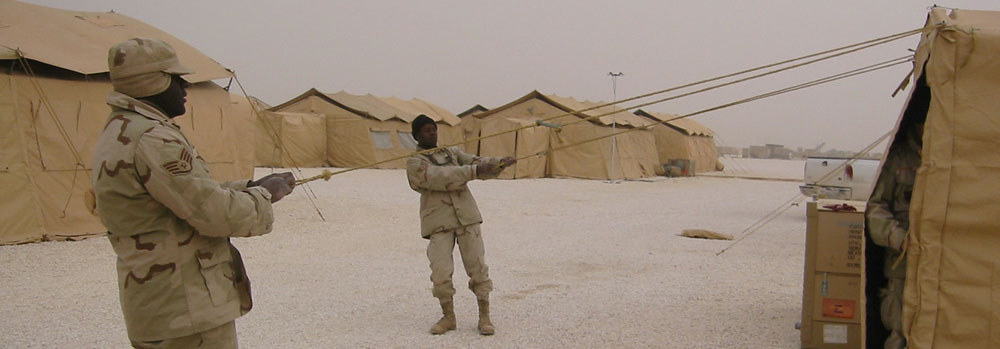
Contractors should take note.
If the key to airpower is flexibility, personnel in an ACE environment have to be extra flexible. We become too comfortable with planning that assumes we will fall in on existing bases that can meet all of our operational requirements. We also believe the numbers in spreadsheets that have everything covered. The experience of the 410th AEW tells us otherwise.
The connective tissue for ACE is people and their ability to weave all requirements into an organized ecosystem for effective combat employment. Training airmen to plan, deploy and operate in the ACE environment is difficult. It’s also critical.
I’m proud to have been a part of the 410th AEW. It was the accumulation of years of training and experiences that came together in a remote place. The wing’s airmen made it work. I hope future airmen will be able to meet the challenge that lies ahead. The art of ACE is something that must be taught, discussed and applied during training in order to be successful while deployed.
Commanders and planners take note — learn to appreciate the utility of a 10K forklift now. It could really pay off in the future.
Retired Lt. Gen. Stanley E. “Sid” Clarke III can be reached via [email protected].
About the Author
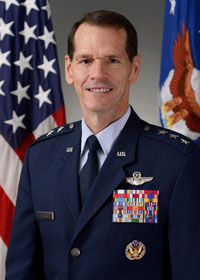
Retired Lt. Gen. Stanley E. “Sid” Clarke III retired in 2016 with 35 years in uniform, including 25 as a member of the Alabama Air National Guard. He is a command pilot with more than 4,000 flight hours, mostly in the A-10 Thunderbolt II and F-16 Fighting Falcon fighters. Clarke’s commands include the 187th Fighter Wing (2002–2005), the 410th Air Expeditionary Wing (2003) and 1st Air Force/Continental U.S. North American Aerospace Defense Command Region (2011–2013). His final assignment was as director of the Air Guard. Today, he is the chairman of the board of Armed Forces Insurance and a consultant to the Patriot Group, a Pasadena, Maryland-based consulting company.
410TH AEW
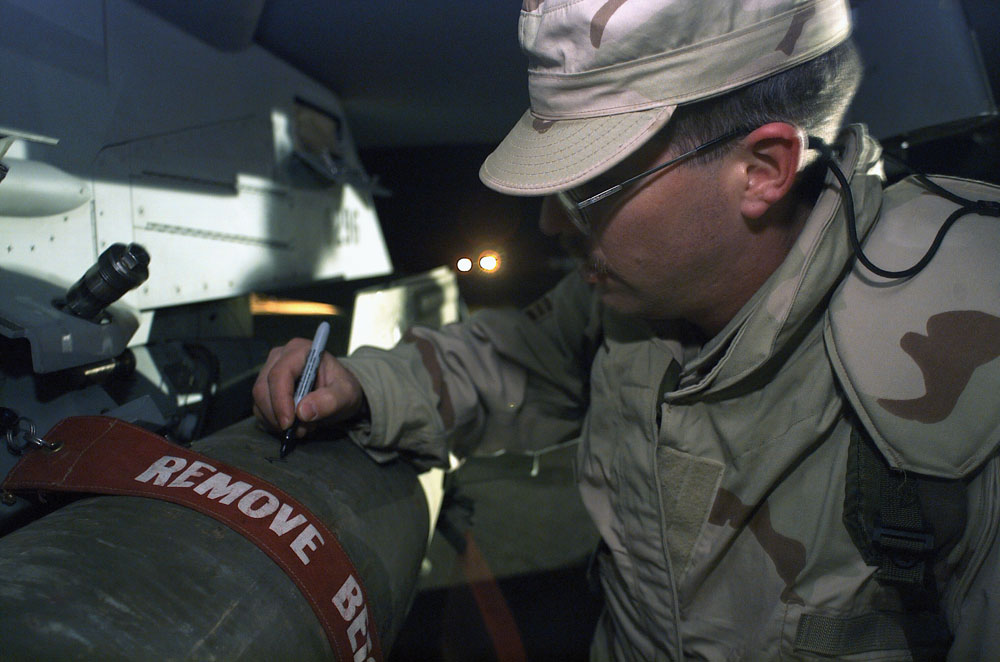
(STAFF SGT. LANIE MCNEAL)
Precise Strikes From Some Rising Stars
The airmen of the 410th Air Expeditionary Wing flew 2,547 sorties in and around Iraq during the first 26 days of Operation Iraqi Freedom in 2003 after building a temporary airbase in Jordan.
Their primary mission was to hunt for and destroy Scud missiles. In addition to eliminating tactical ballistic missile equipment, the wing destroyed aircraft, armored vehicles, artillery pieces, other surface-to-air missile systems, ammunition supply dumps, radars and enemy troops.
The wing accurately fired more than 600 precision-guided munitions and a total of 800,000 pounds of ordnance, according to historical reports. Along the way, not a single mission was canceled for maintenance. There were also no aircraft mishaps or fratricide incidents.
The Air National Guard from several states provided the bulk of the airmen and nearly all of the wing’s fighter aircraft — A-10 Thunderbolt IIs from Connecticut and Massachusetts and F-16 Fighting Falcons from Alabama and Colorado.
The wing also produced some of the Air Guard’s recent senior leaders, including the last three Air Guard directors — retired Lt. Gen. Stanley E. “Sid” Clarke III (2012-2016), retired Lt. Gen. L. Scott “Catfish” Rice (2016-2020) and Lt. Gen. Michael A. Loh (2020-present).
Lt. Gen. Marc H. Sasseville, the current vice chief of the National Guard Bureau, was also a pilot in the wing.
—NGAUS staff report

